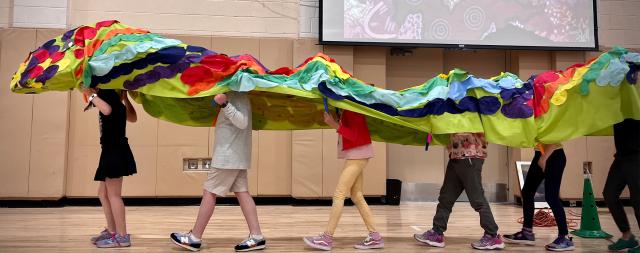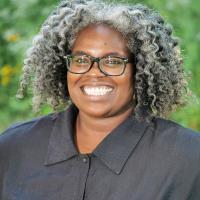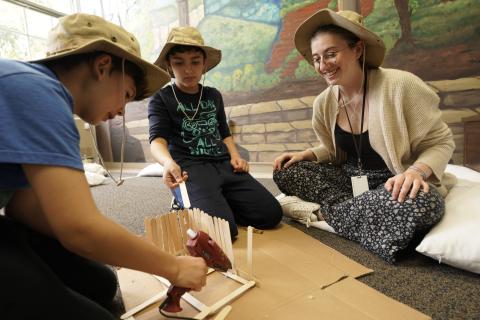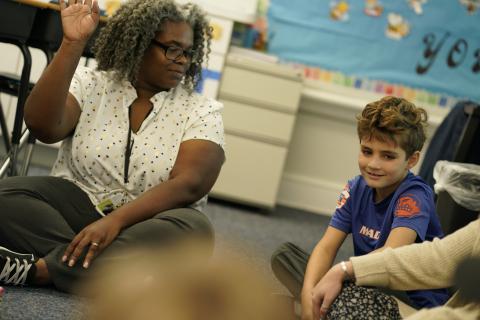

Adzua Robinson
Math and Academic Club Teacher
World Cultures Club Offers a Window to Other Perspectives
World Cultures Club uses art, storytelling, and curiosity to introduce students to ancient cultures from around the globe. Drawing on her own interests exploring the world, Math Teacher and Academic Club Teacher Adzua Robinson created the Club to give her students a way to see the common experiences between different groups of people.
"We go to Africa, Europe, and Asia, North and South America, and Australia. We travel around the globe to study the cultures of old."
At the beginning of each class these words are repeated in unison by every student in the World Cultures Club while facing the large map of the world that dominates one wall of the classroom. Created by Lower School teacher Adzua Robinson, World Cultures Club is the newest of Lab’s Academic Clubs, one of the foundational methodologies of The Lab School pioneered by founder Sally Smith. Like all of the Academic Clubs at Lab, World Cultures Club is a hands-on experience in which students use costumes and art projects to fully immerse themselves in their studies.
The young anthropologists in the Club follow a winding path around the globe as they hop from continent to continent looking for people groups and learning about what they do. Focusing on the time frame of the Middle Ages, the class attempts to expand the world view of that period beyond the typical emphasis on Europe. Beginning with the Yolngu and Ngarinyin peoples native to Australia, the class moved through Indonesia and India before making stops along the Silk Road as they traveled west through Asia, Africa, and Europe, and ending their studies in the Americas.

As they forge this path across the world from unit to unit, students can choose how they engage with the cultures they are studying. For example, while studying the Inuit peoples inhabiting the Arctic, some students focused on an art project recreating the aurora borealis, or northern lights, which are important to Inuit mythology, while others ventured outside to imagine a hunt for the polar bears that can be a part of the typical high-protein, high-fat Inuit diet. By comparing differences such as the food people eat or the stories they tell, the students are also learning about the humanity of these groups that make them the same.
“A lot of kids in my class had very little experience engaging with other groups of people,” says Ms. Robinson. “The new Club is about being able to present different cultures to the kids. It’s not weird, it’s just different.” Ms. Robinson’s work on the World Cultures Club resulted in her receiving the Steve Wolfe Innovative Teaching Award.
In developing the new Club, Ms. Robinson worked closely with Head of Academic Clubs Liora Valero to develop a course that supported the school’s Diversity, Equity, Inclusion, and Belonging (DEIB) goals. “The Academic Club system offers doors, mirrors, and windows to other perspectives,” explains Ms. Liora. This goes beyond geographic or racial differences, applying to multiple intelligences and neurodiversity as well. “There were empires that thrived without reading and writing,” she adds. “Our goal is to build up the idea that it’s a big world and that all of our identities are valid.”

The idea for the new Club grew out of two units that Ms. Robinson had introduced while teaching its predecessor, American Revolution Club. In addition to the traditional focus on the Founding Fathers, she had introduced units on Native Americans and West Africans to the class as a way to explore other perspectives of the era. “The kids know who Pocahontas is, but I wanted them to understand that these people have their own stories,” Ms. Robinson says. Even so, these units had to deal with the ways these groups were oppressed and enslaved by the American colonists. Taken in combination with the role-playing involving students dressing as the colonists, it was clear that there might be a more appropriate direction to take the class. “It’s a nuanced time to explore at that age,” notes Ms. Liora. To best explore these topics, she asked herself, “How can we take the good, acknowledge the bad, repair harm, and find the true American dream?” Ultimately, knowing that students would later cover US History in their social studies class allowed Ms. Robinson to make the shift to a more global centric perspective in the new Club.
The preexisting units on the Asante people of Ghana and the Anacostan tribe native to what is now Washington DC became jumping-off points as Ms. Robinson brainstormed how to organize World Cultures Club. She ended up using her own interests in traveling to develop the globetrotting perspective of the club. “It’s what I like to do: I enjoy going from place to place to learn about the similarities between people,” explains Ms. Robinson. “What are the common experiences between incredibly different groups of people?” All around the world people are united by the need for companionship, food, and shelter. They get married, have children, and form communities. Through religion and myth, different people around the world question where we came from and what happens after death. By studying how a group’s environment shapes these shared experiences, students have the opportunity to expand their worldviews and appreciate cultures outside of their own. As Ms. Robinson reminds us, “We all need a little practice respecting the differences of others and noticing them in a good way.”


